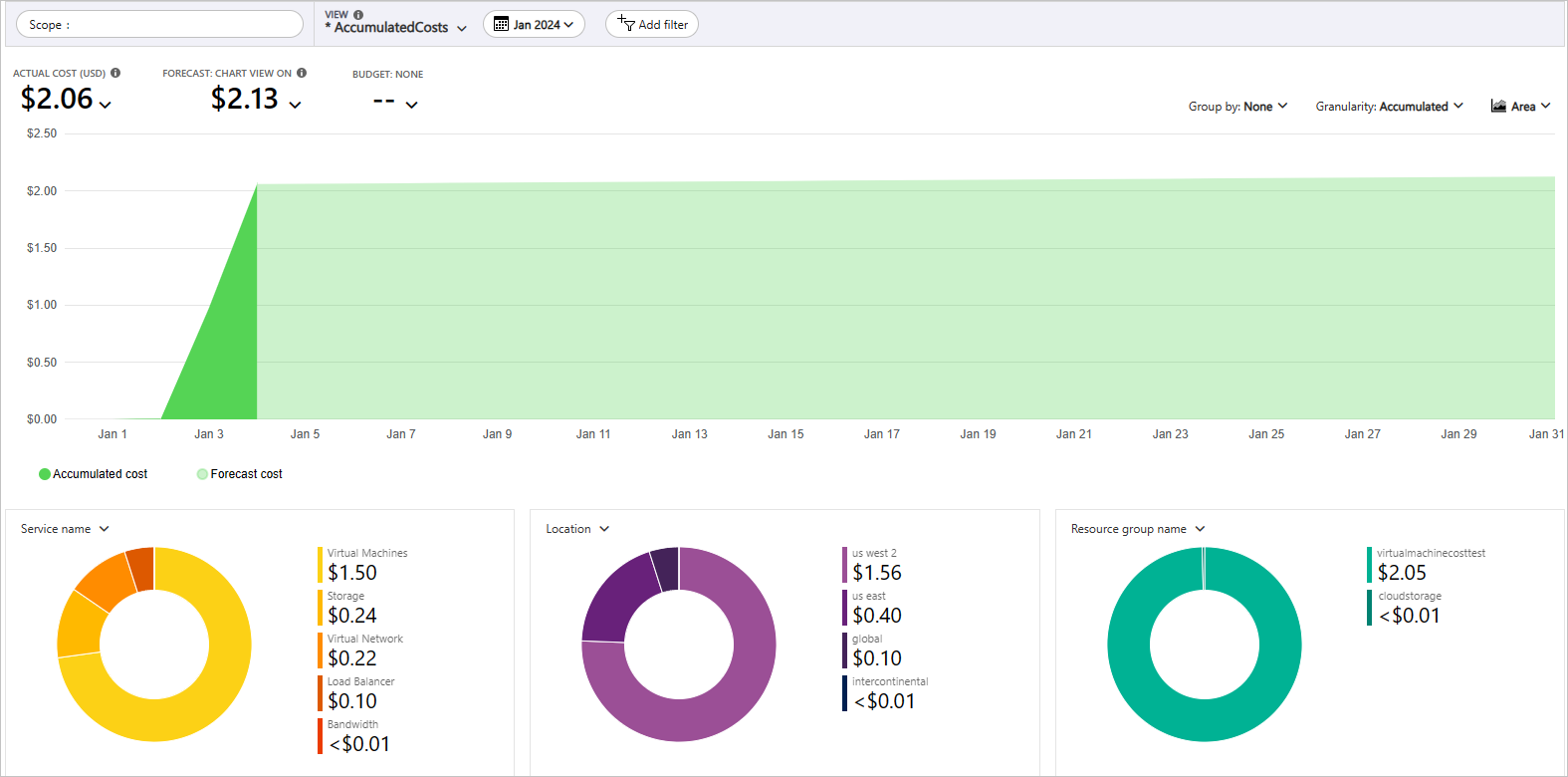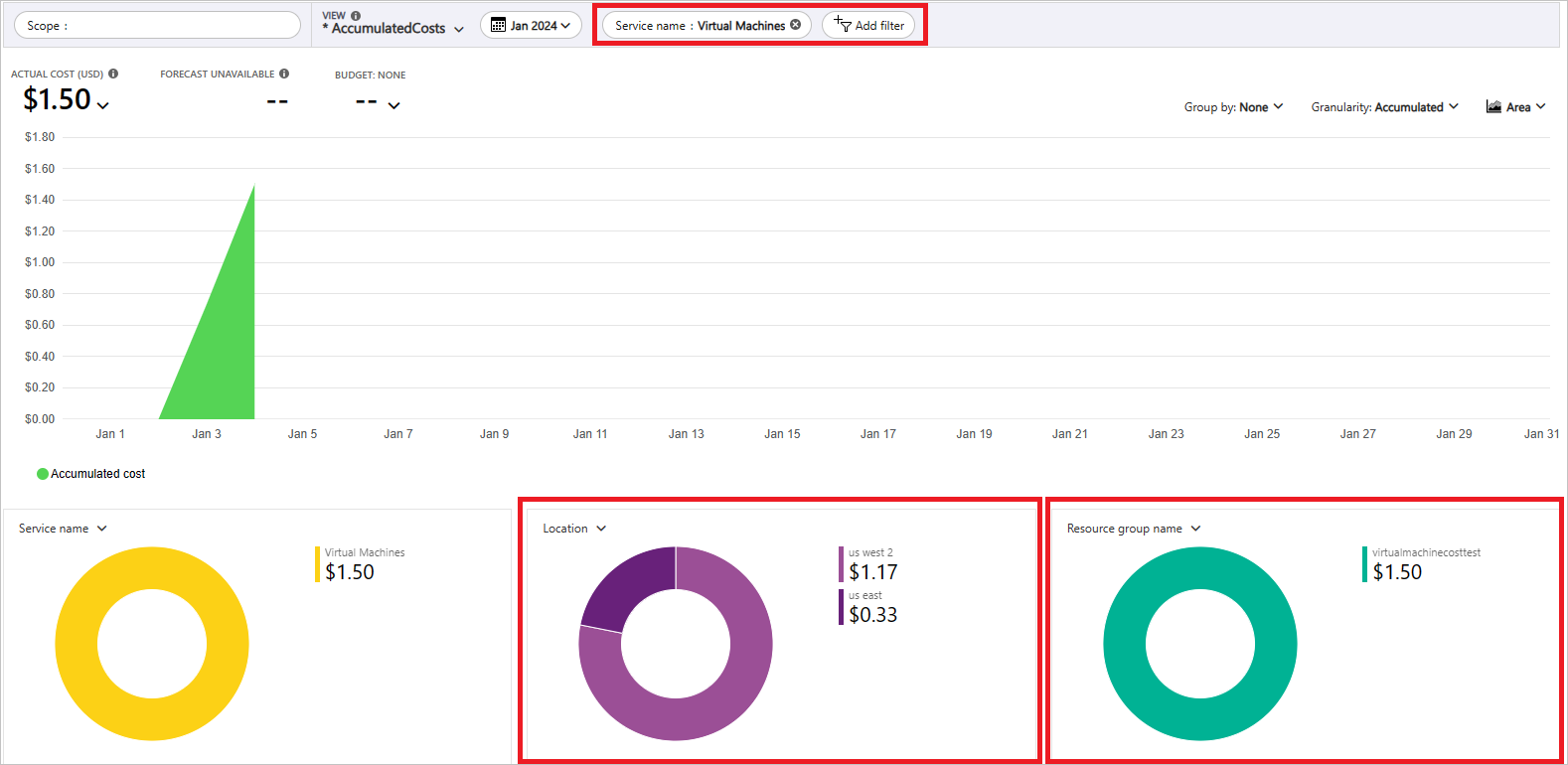Note
Access to this page requires authorization. You can try signing in or changing directories.
Access to this page requires authorization. You can try changing directories.
This article describes how you monitor costs for virtual machines.
If you'd like to see how the billing model works for virtual machines and how to plan for costs ahead of resource deployment, see Plan to manage costs. If you'd like to review the best practices for virtual machine cost optimization, see Best practices for virtual machine cost optimization.
After you start using virtual machine resources, use Cost Management features to set budgets and monitor costs. You can also review forecasted costs and identify spending trends to identify areas where you might want to act. Costs for virtual machines are only a portion of the monthly costs in your Azure bill. Although this article explains how to plan for and manage costs for virtual machines, your bill includes the costs of all Azure services and resources used in your Azure subscription, including the third-party services. You can learn more about the billing model in Plan to manage costs.
In this article, you'll learn how to:
- Monitor virtual machine costs
- Create budgets for virtual machines
- Export virtual machine cost data
Prerequisites
Cost analysis in Cost Management supports most Azure account types but not all of them. To view the full list of supported account types, see Understand Cost Management data. To view cost data, you need at least read access for an Azure account. For information about assigning access to Microsoft Cost Management data, see Assign access to data.
Monitor costs
As you use Azure resources with virtual machines, you incur costs. Azure resource usage unit costs vary by time intervals (seconds, minutes, hours, and days) or by unit usage (bytes, megabytes, and so on.) As soon as virtual machine use starts, costs are incurred, and you can see the costs in cost analysis.
When you use cost analysis, you view virtual machine costs in graphs and tables for different time intervals. Some examples are by day, current and prior month, and year. You also view costs against budgets and forecasted costs. Switching to longer views over time can help you identify spending trends, and you can see where you might be overspending. If you create budgets, you can also easily see where they're exceeded.
To view virtual machine costs in cost analysis:
Sign in to the Azure portal.
Open the scope in the Azure portal and select Cost analysis in the menu. For example, go to Subscriptions, select a subscription from the list, and then select Cost analysis in the menu. Select Scope to switch to a different scope in cost analysis.
By default, cost for services are shown in the first donut chart. Select the area in the chart labeled virtual machines.
Note
If you just created your virtual machine, cost and usage data is typically only available within 8-24 hours.
Actual monthly costs are shown when you initially open cost analysis. Here's an example showing all monthly usage costs.
To narrow costs for a single service, like virtual machines, select Add filter and then select Service name. Then, select Virtual Machines.
Here's an example showing costs for just virtual machines.
In the preceding example, you see the current cost for the service. Costs by Azure regions (locations) and virtual machines costs by resource group are also shown. From here, you can explore costs on your own.
Create budgets
You can create budgets to manage costs and create alerts that automatically notify stakeholders of spending anomalies and overspending risks. Alerts are based on spending compared to budget and cost thresholds. Budgets and alerts are created for Azure subscriptions and resource groups, so they're useful as part of an overall cost monitoring strategy.
Budgets can be created with filters for specific resources or services in Azure if you want more granularity present in your monitoring. Filters help ensure that you don't accidentally create new resources that cost you more money. For more information about the filter options available when you create a budget, see Group and filter options.
Export cost data
You can also export your cost data to a storage account. This is helpful when you need or others to do additional data analysis for costs. For example, a finance team can analyze the data using Excel or Power BI. You can export your costs on a daily, weekly, or monthly schedule and set a custom date range. Exporting cost data is the recommended way to retrieve cost datasets.
Next steps
In this article, you learned how to monitor virtual machine costs, create budgets, and export cost data.
For more information on virtual machine cost optimization, see the following articles:
- Learn how to plan to manage costs for virtual machines.
- Review the virtual machine cost optimization best practices.
- Learn how to optimize your cloud investment with Microsoft Cost Management.
- Learn more about managing costs with cost analysis.
- Learn about how to prevent unexpected costs.
- Take the Cost Management guided learning course.
- Learn how to create Linux and Windows virtual machines.
- Take the Azure Well-Architected Framework - Cost Optimization training.

